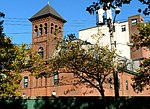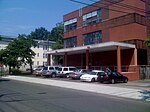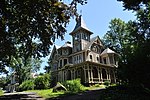Fair Haven Union Cemetery
Fair Haven Union Cemetery, located at 149 Grand Ave., covers 7 acres (28,000 m2) in the neighborhood of Fair Haven, Connecticut. Although graves were there as early as 1803, the land was donated for the cemetery by local farmers Stephen Rowe and Nathaniel Granniss in 1808. The site included land for a meeting house, a school, and parade grounds, as well as 1-acre (4,000 m2) for burial, holding 80 lots. A Victorian Gothic entry arch was added in 1885 inscribed with a quote from Revelation 14:13, "They rest from their labors." In April 2006, the cemetery was evaluated for restoration. Including a formal cost study and beautification. Recommendations included protection from intruders and vandals, as well as different fencing to block out the view of adjacent housing. The area Cemetery Board declined to pursue the recommendations, but agreed to consider nominating the site for addition to the National Register of Historic Places.
Excerpt from the Wikipedia article Fair Haven Union Cemetery (License: CC BY-SA 3.0, Authors).Fair Haven Union Cemetery
Chapel Street, New Haven
Geographical coordinates (GPS) Address Nearby Places Show on map
Geographical coordinates (GPS)
| Latitude | Longitude |
|---|---|
| N 41.3092 ° | E -72.893 ° |
Address
Quinnipiac Avenue Historic District
Chapel Street
06515 New Haven
Connecticut, United States
Open on Google Maps









